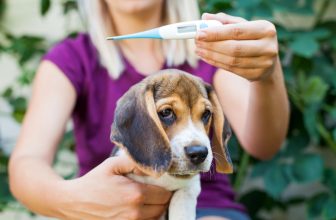
Alopecia, commonly known as hair loss, is a common condition in dogs. While all dogs may be at risk of developing varying degrees of alopecia, there are contributing factors that may predispose your dog to this condition. Understanding the top reasons in which your dog may develop hair loss, as well as steps to take toward a diagnosis, plays a tremendous role in treating your dog’s alopecia.
5 common causes for alopecia in dogs and how to treat them
Thyroid disease
Hypothyroidism, or an underactive thyroid gland, is an extremely common condition in dogs. Many times, undiagnosed hypothyroidism will cause hair loss or thinning in dogs. Alopecia from hypothyroidism is typically located on a dog’s trunk or tail. Your veterinarian will run blood work to rule out or confirm thyroid disease in your dog and it is generally very well managed with medication and routine thyroid blood work.
Allergies
Both food and environmental allergies are common conditions accompanied with alopecia. These dogs often have patches of hair missing or struggle with hot spots and salivary staining, due to chronic itchiness and scratching. The best approach to diagnosing and treating your allergic dog is to establish a relationship with a board-certified veterinary dermatologist. Use the American College of Veterinary Dermatology’s website to search for a local dermatologist.
Behavior
Some dogs may develop alopecia from overgrooming. While this is more common in cats, dogs who are experiencing fear, stress or anxiety may overgroom certain areas of their bodies. Think of this as a nervous tick, such as biting your nails or twirling your hair. Managing the root behavior is key to managing this type of alopecia. Management and treatment may include pharmaceutical and nutraceutical medication, increased mental and physical enrichment, as well as identifying and modifying environmental stressors for your pup.
Cushing’s Disease
Cushing’s Disease in dogs occurs when the adrenal glands produce an excess of cortisol. Among a myriad of other tell-tale symptoms, one of the most common signs of Cushing’s Disease in dogs is alopecia. While it can be somewhat tricky to diagnose, veterinarians usually use a combination of ultrasounds and blood tests to confirm Cushing’s Disease in your dog. Medications, Chinese herbs and dietary changes can all be used to treat this disease.
Alopecia X
“Alopecia X” is a name given to hereditary alopecia most commonly seen in Nordic breeds such as Pomeranians, American Eskimos and Chow Chows. Alopecia X typically causes baldness along the entire body and is only cosmetically concerning. A skin biopsy is typically necessary for diagnosing this condition. According to Dr. Angie Krause, holistic veterinarian at Boulder Holistic Vet, Alopecia X can be successfully managed using the Chinese herb, Bu Gan Tang.
Understanding the root cause of your dog’s alopecia will be absolutely critical to treating it! Most conditions that are associated with alopecia are very treatable using both traditional and holistic approaches. Keep open communication with your veterinarian and expand your dog’s medical team when you feel it is necessary. You are your dog’s biggest medical advocate!
<
Credit Source link







